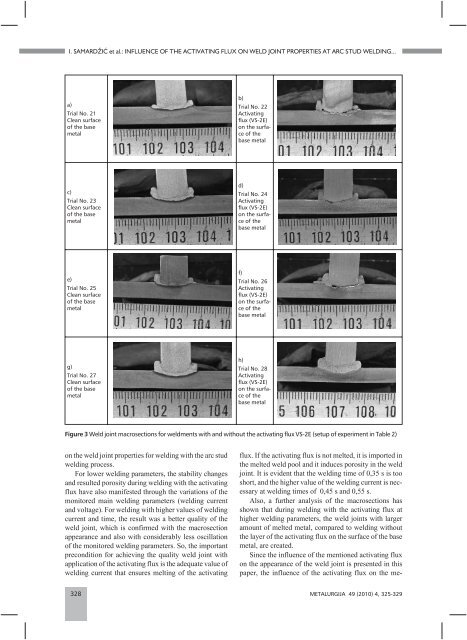PDF - 3756 kB - CARNet
PDF - 3756 kB - CARNet
PDF - 3756 kB - CARNet
Create successful ePaper yourself
Turn your PDF publications into a flip-book with our unique Google optimized e-Paper software.
I. SAMARD@I] et al.: INFLUENCE OF THE ACTIVATING FLUX ON WELD JOINT PROPERTIES AT ARC STUD WELDING...<br />
a)<br />
Trial No. 21<br />
Clean surface<br />
of the base<br />
metal<br />
c)<br />
Trial No. 23<br />
Clean surface<br />
of the base<br />
metal<br />
e)<br />
Trial No. 25<br />
Clean surface<br />
of the base<br />
metal<br />
g)<br />
Trial No. 27<br />
Clean surface<br />
of the base<br />
metal<br />
on the weld joint properties for welding with the arc stud<br />
welding process.<br />
For lower welding parameters, the stability changes<br />
and resulted porosity during welding with the activating<br />
flux have also manifested through the variations of the<br />
monitored main welding parameters (welding current<br />
and voltage). For welding with higher values of welding<br />
current and time, the result was a better quality of the<br />
weld joint, which is confirmed with the macrosection<br />
appearance and also with considerably less oscillation<br />
of the monitored welding parameters. So, the important<br />
precondition for achieving the quality weld joint with<br />
application of the activating flux is the adequate value of<br />
welding current that ensures melting of the activating<br />
b)<br />
Trial No. 22<br />
Activating<br />
flux (VS-2E)<br />
on the surface<br />
of the<br />
base metal<br />
d)<br />
Trial No. 24<br />
Activating<br />
flux (VS-2E)<br />
on the surface<br />
of the<br />
base metal<br />
f)<br />
Trial No. 26<br />
Activating<br />
flux (VS-2E)<br />
on the surface<br />
of the<br />
base metal<br />
h)<br />
Trial No. 28<br />
Activating<br />
flux (VS-2E)<br />
on the surface<br />
of the<br />
base metal<br />
Figure 3 Weld joint macrosections for weldments with and without the activating flux VS-2E (setup of experiment in Table 2)<br />
flux. If the activating flux is not melted, it is imported in<br />
the melted weld pool and it induces porosity in the weld<br />
joint. It is evident that the welding time of 0,35 s is too<br />
short, and the higher value of the welding current is necessary<br />
at welding times of 0,45 s and 0,55 s.<br />
Also, a further analysis of the macrosections has<br />
shown that during welding with the activating flux at<br />
higher welding parameters, the weld joints with larger<br />
amount of melted metal, compared to welding without<br />
the layer of the activating flux on the surface of the base<br />
metal, are created.<br />
Since the influence of the mentioned activating flux<br />
on the appearance of the weld joint is presented in this<br />
paper, the influence of the activating flux on the me-<br />
328 METALURGIJA 49 (2010) 4, 325-329
















